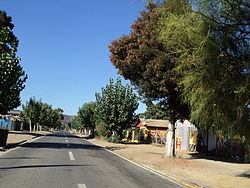Navidad, Chile
| Navidad | |||||
|---|---|---|---|---|---|
| Commune | |||||
 |
|||||
|
|||||
| Coordinates (city): 33°57′S 71°50′W / 33.950°S 71.833°WCoordinates: 33°57′S 71°50′W / 33.950°S 71.833°W | |||||
| Country |
|
||||
| Region |
|
||||
| Province |
|
||||
| Government | |||||
| • Type | Municipality | ||||
| • Alcalde | Horacio Maldonado Mondaca | ||||
| Area | |||||
| • Total | 300.4 km2 (116.0 sq mi) | ||||
| Elevation | 24 m (79 ft) | ||||
| Population (2012 Census) | |||||
| • Total | 5,324 | ||||
| • Density | 18/km2 (46/sq mi) | ||||
| • Urban | 712 | ||||
| • Rural | 4,710 | ||||
| Sex | |||||
| • Men | 2,878 | ||||
| • Women | 2,544 | ||||
| Time zone | CLT (UTC-4) | ||||
| • Summer (DST) | CLST (UTC-3) | ||||
| Area code(s) | (+56) 72 | ||||
| Website | Municipality of Navidad | ||||
Navidad (Spanish pronunciation: [naβiˈðað]) is one of the six communes in Cardenal Caro Province, O'Higgins Region, Chile. It borders the commune of Santo Domingo (Valparaíso Region) and San Pedro (Santiago Metropolitan Region) in the north, the commune of Litueche to the east and south, and the Pacific Ocean to the west. The commune has approximately 20 kilometres of coastline.
According to the 2002 census of the Chilean National Statistics Institute, Navidad spans an area of 300.4 km2 (116 sq mi) and has 5,422 inhabitants (2,878 men and 2,544 women). Of these, 712 (13.1%) lived in urban areas and 4,710 (86.9%) in rural areas. The population fell by only 1 person between the 1992 and 2002 censuses.
The landscape of the commune is predominantly plateau, rolling hills and ravines, common features of the central coastline of Chile. The Rapel River is the main water source, though there are also some small streams and lagoons, such as El Culenar.
Navidad has attracted visitors due to its unusual geological feature, the Navidad Formation, marine rock strata containing fossilised marine life dating from the late Miocene to the early Pliocene eras, approximately 5 million years ago. The formations were studied by the English naturalist Charles Darwin in the 19th century. The French scientist and painter Claudio Gay was also commissioned by the Chilean government to study the area, as was the German geologist Rodolfo Philippi.
...
Wikipedia



